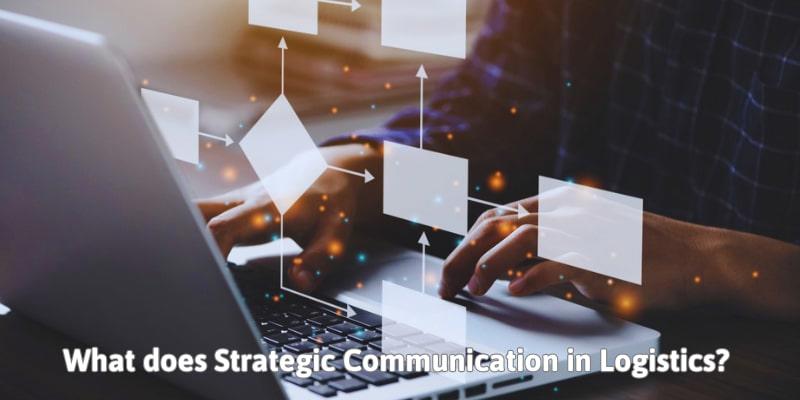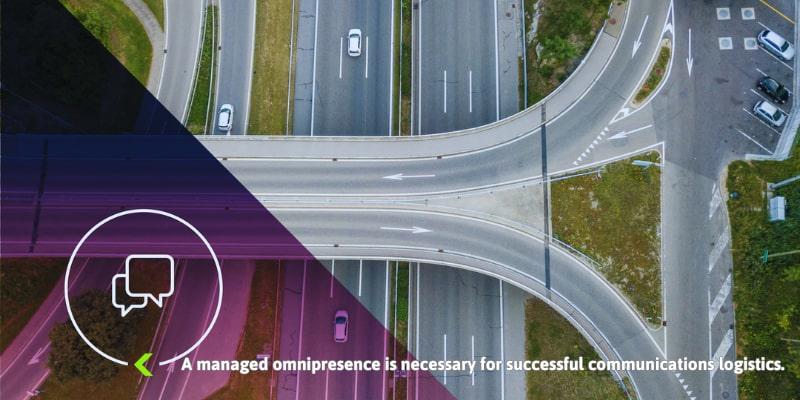
Starting June 1st, 2023 Our warehouse fee will be $0.65/cubic foot per month
In effort to lower the warehouse storage fee during inflation, we have went narrow aisle racking.This construction took us four months but the project is finally completed. With narrow aisle racking, we are able to drop storage by 24%.We as partners will go through this inflation together.
02/15/2024
The process by which information, news, or knowledge is conveyed between the "sender" and the "receiver" is the definition of communication. Interpersonal communication, which involves two people, can involve any number of participants, as can group communication and client communication. The logistics sector actually offers the chance to use every kind of communication. Strategic communication is essential for everyone involved in the freight delivery process, including drivers, clients, 3PLs, and trucking companies.

Communication is actually a little more complicated than that, despite the fact that many people think it to be just two individuals having a back and forth conversation. There are 4 to 10 critical processes in the communication process, according to some theories. We will simply go through the 4 steps of communication for the purposes of this blog in order to keep things simple.
The communication process starts with the sender, who is the individual who wants to communicate a message or information to a receiver. First, the sender must convert their thoughts or ideas into a format that can be communicated. This encoding can be expressed in a variety of ways, including spoken language, written text, gestures, and visual symbols. The message's sender must take their audience into account when determining the best way to deliver it.
The message is then transferred across the selected communication channel after being encoded. A face-to-face discussion, a phone call, a written document, an email, a text message, or even non-verbal indications like a gesture or a facial expression might serve as this channel. Considerations including the message's urgency, the receiver's preferences, and the intricacy of the information should all be taken into account while selecting a channel.
The person or group intended to receive the communication is referred to as the recipient. The receiver's job is to understand or decode the message after it is received. This stage is essential because it establishes whether the sender's intended meaning was conveyed in the communication. The way the message is interpreted can be impacted by things like linguistic limitations, cultural variances, and individual prejudices. Clarity in encoding and efforts to reduce decoding obstacles are necessary for effective communication.
The process of communication is not complete without feedback. After deciphering the message, the recipient may reply to the sender with their ideas, inquiries, or feelings. This response is proof positive that the message was heard and understood clearly. It also gives the sender the chance to address any miscommunications or, if required, modify their message. To ensure that their communications are understandable and well-received, effective communicators actively seek out and value feedback.
Learn other terms now:

A cost-effective and flexible logistics management method depends heavily on information exchange. It guarantees that tasks are carried out and moved from one place to another quickly and effortlessly.
For instance, the customer service department wants information to update shipping status, the sales department needs information to assess orders that have been dispatched, and the accounts department needs information to cross-check transporter invoices. When choosing new vendors or renewing existing contracts, the procurement team needs information from logistics. For the supply chain to perform well, the other functions must cooperate or communicate with the logistics team.
In addition to the internal information requirements, vendors including carriers, warehouse managers, and 3PLs must regularly communicate with the logistics team in order to guarantee that the company's items are delivered on time, at the appropriate location, and for the right price.

👉 It should be in writing: Written communication is crucial because it reduces the possibility that someone would misunderstand or forget the message. The most typical method of business communication today is written communication. It is imperative for all professionals to have strong written communication skills and to promote the same in all employees because emails and all other kinds of messages delivered across different platforms may be transmitted with ease to numerous receivers located across offices, nations, and continents.
The characteristic of excellent communication is a message that is clear, succinct, and consistent.
It should adhere to the three C's, which stand for clear, concise, and consistent messages. A clear communication guarantees that what needs to be said is understood by all. Conciseness makes ensuring the message is short but contains all relevant information. Additionally, if the language, format, and delivery are consistent, the recipient won't have to spend extra time comprehending the message.
Since most of the work in logistics is time-sensitive, it is crucial to label the correct team or individual on emails.
It should be sent to the appropriate parties: Information is frequently misplaced in organizational hierarchies because it is not directed to the appropriate party. Since most of the work in logistics is time-sensitive, it is crucial to label the correct team or individual on emails.
👉 It conveys urgency correctly: Many CEOs have a practice of designating all emails as "urgent" to guarantee that the recipient will give it their undivided attention. While this method is excellent for making sure that crucial and significant communication is not missed, it becomes challenging to prioritize activities if all communication is urgent. Additionally, it weakens the meaning of the word. In such cases, the recipients start working on the duties in the order they believe to be appropriate. It is essential to designate just the communications or tasks that are of the utmost importance as urgent, and not all communication.
👉 It should provide clear timelines: The message should make clear the delivery deadline, the timeframe for receiving a response, and the work that is being allocated. This will save unneeded delays and enable the recipient gather information, plan, and carry out the tasks indicated in the communication.
It needs to be open and trustworthy since internal rivalries, office politics, and fierce competition tempt workers to withhold information from their coworkers or superiors. Task completion is hampered by the resulting confusion, disarray, and mistrust. Therefore, it is crucial that organizational culture encourages open communication and the dissemination of trustworthy information.
👉 It should be real-time: Information sharing needs to be speedy because logistics is a fast-paced function. As a result, information like updated freight rates, loading lists, client orders, etc. needs to be validated and passed on to the next person as soon as it is received. In addition to these guidelines, questions asked about a task or procedure should be immediately answered, or the recipient should at the very least give a schedule by which the sender may anticipate receiving a response.
👉 Integration of technology: In the current digital era, effective written communication is no longer sufficient to guarantee that corporate strategies will be implemented successfully. To guarantee that information transfers smoothly and without manual intervention from one function to another, organizations must also integrate the technologies, backend systems, and processes used by various departments.

The coordination and transportation of commodities, information, and resources throughout supply chains is a complex and important activity that is a part of strategic communication in the logistics sector. The timely delivery of goods and services, the reduction of errors, and the general optimization of logistics operations all depend on effective strategic communication. The logistics sector's use of strategic communication is broken down as follows:
💡 Strategic order initiation: It is frequently the first step in strategic communication in logistics. In this step, the sender, who could be a client, a store, or even a department inside a business, strategically encrypts their request for goods or services. This request could include detailed information such product descriptions, quantity requirements, delivery dates, and destination data. In order to prevent delays or misunderstandings, it is imperative that the sender supply correct and comprehensive information.
💡 Order processing and routing: After the order is strategically started, the logistics network transmits it. The logistics provider must first accept the order, process it, and then decide on the best possible course and mode of transportation. To guarantee that the order is routed correctly and effectively, it is essential for several departments within the logistics organization, such as strategic order processing, warehousing, and transportation, to have effective strategic communication.
💡 Transportation and tracking: Moving products physically is the next strategic step. This often calls for tactical communication between the logistics provider—such as a shipping company—and the tactical transportation staff in charge of packing, shipping, and delivering the goods. To give visibility into the location and status of shipments, real-time tracking and monitoring solutions are frequently strategically used. Both internal and external stakeholders can be informed of this information to keep them updated on the status of their orders.
💡 Delivery Confirmation and Documentation: As items are delivered strategically, effective communication between the delivery team and the recipient is essential. The strategic delivery team must verify successful delivery, secure required signatures or documentation, and diplomatically relay any problems or discrepancies to the logistics firm. To maintain responsibility and strategically handle any issues that may emerge, accurate strategic record-keeping and documentation are crucial.
💡 Input and Continuous Improvement: The final strategic step in the logistics communication process entails carefully assembling input from various stakeholders, such as clients, internal teams, and partners. This input assists in identifying critical areas for logistics operations improvement. It might have to do with problems like slow deliveries, ruined goods, or poor communication. Effective logistics businesses use this tactical input to hone their procedures, boost productivity, and raise overall client happiness.
For the logistics sector to maintain a seamless flow of information and goods, timely and accurate strategic communication is essential. The efficient delivery of goods and the rapid resolution of any issues are ensured by effective strategic coordination among many stakeholders, including customers, logistics providers, strategic transportation professionals, and warehousing teams. As technology develops, logistics businesses increasingly rely on strategic digital tracking systems and communication tools to organize their operations and give real-time updates to all parties engaged in the supply chain managment (SCM).

With regard to marketing, public relations, crisis management, or any other area of internal or external communication within an organization, these four stages of strategic communication offer a methodical and iterative approach to achieving communication goals.

The following are the responsibilities that must be completed by all service providers if they are to succeed in this competitive business environment, according to the eight rules of successful communication logistics:
Customers may search and compare goods and services with ease thanks to a variety of content that is publicly and constantly accessible.
The risk of having their content viewed as spam exists for providers who do not consistently alter their communications to meet the needs of their clients. Particularly in the case of the post-sale relationship.
Tasks:
Analysis of the purchase process and motivation in great detail
(Data and profile analysis) Comprehensive analytical CRM
Existing customer intermediaries (retail, service providers, including CEP services), which can transmit requirements-based material continuously both locally and nationally when they are aware of customers' wants and wishes, must reposition themselves. This is true for both CEP products and services as well as for goods and services provided by CEP service partners.
Tasks:
The role of intermediaries has to be updated.
Based on unique characteristics and credentials, trust and added value must be provided.
The end-user must be considered while designing each cross-selling capability.

The connection between the online and offline worlds is already a fact for customers. Individuals' daily behaviors are changing as a result of global networks. Anyone that engages with their consumers across a variety of channels and provides them with a range of options has the opportunity to benefit from useful synergies since they can reach them wherever they may be.
Tasks:
Examine your sales routes
Locate prospective channels for a connection and post offers.
Become a reliable helper who resembles a butler.
Systems must be networked in order for businesses to reach out to their own customers through a variety of touch points.
Tasks:
Find out where your customers will be touched.
Think about how your present consumer touch points can be used as a tool for collaboration.
The adage that it costs less to keep existing customers than to acquire new ones conceals a lot of potential.
In order to choose the best model for calculating a client's actual value and comprehend what factors affect customer loyalty, customized communications logistics are becoming more and more crucial.
Tasks: Think about how to get to know every single consumer better.
It is crucial to carefully evaluate a customer's worth. Each participant in a conversation must be presented with the product and service option that best suits them and is lucrative for the supplier.
Tasks: Engage your clients to assist them in enhancing their own profiles, whether it be a real one or one they want.
Client relationships are limited. not just due to biological factors. Customers are flexible beings, and their level of loyalty changes over the course of their lives.
Even after a consumer no longer uses the company's services, they can still contribute significantly to its financial success by referring new clients to the business and/or its products.
Anyone who is aware of the "opinion leader potential" of customers might encourage them to express their ideas. The foundation for both a qualitative and quantitative increase in loyalty is here.
Tasks:
Activate your inner opinion leader
Encourage and encourage those who are willing to express their opinions
Utilizing opinion leader methods is key to effective communications logistics. Businesses that are successful provide their clients services that go beyond their areas of expertise. As a result, recommendations are prompted and enthusiasm is generated.
Task:
Most clients are very predictable. Take up residence in their "micro-cosmos"
Telecommunications, energy, transport, and logistics, the industries currently most adversely affected by digitalization, will take the lead in developing new business models that fully take into account these logistics principles for communication.
The consumer (and anything controlled or connected to him) will become a vital aspect, if not the focus, of value creation as a result of communication logistics, which already clearly places the consumer at the center of any engagement.

A powerful tool, strategic communication aids organizations in accomplishing their objectives, building deeper relationships, and successfully navigating challenging business situations.
Clarifying a company's vision and goals is a key function of strategic communication. It is possible to foster a sense of unity and shared purpose and ensure that everyone is moving in the same direction by clearly articulating these goals to staff members, stakeholders, and clients. Furthermore, it is essential for forging strong bonds with a range of stakeholders, including staff members, clients, investors, and the general public. Sharing information in a consistent, open, and credible manner builds credibility and trust—two essential elements of long-term success.
For productivity and retention, including employees in the mission and values of the business is crucial. Employees are kept informed through strategic communication, which also fosters their sense of community and equips them with the skills they need to succeed in their jobs. Strategic communication serves as the compass that directs businesses through inescapable crises and problems. It enables them to react quickly and efficiently, preventing possible harm to their reputation and giving stakeholders comfort.
The distinctiveness of brands is assisted by strategic communication. It lets businesses to specify and persuasively present to their target market their unique selling propositions, differentiating them from rivals and drawing in and keeping clients. Companies that promote open communication channels increase their chances of seeing innovative ideas emerge through fostering creativity and adaptation. Their capacity for adaptation enables them to react quickly to shifting consumer demands and changing market situations.
Making wise decisions is essential for success, and strategic communication gives leaders the information and understanding they need. It makes certain that decision-makers have a thorough awareness of conditions and potential effects. Strategic communication is essential to controlling and enhancing a company's reputation, which is one of its most valuable assets. Positive reputations are kept through taking proactive measures to resolve problems, controlling public opinion, and demonstrating a dedication to moral behavior.
Efforts in marketing and sales are also driven by strategic communication. The key to bringing in new business and keeping existing ones is to create communications that are appealing and that are aware of the target demographic.
Last but not least, it's important to make sure that regulations are followed, and effective communication is key to this. It makes sure that stakeholders and employees are aware of industry rules and the company's commitment to following them. Strategic communication is not only important but also essential in today's fast-paced and interconnected business environment. Businesses that place a high priority on effective communication as part of their entire strategy are more likely to be able to adapt to change, involve stakeholders, and experience sustained growth. In the contemporary business world, it is regarded as a crucial factor in success.
In conclusion, effective strategic communication is essential to the logistics sector's success since it connects every link in the supply chain. Customers, partners, and employees all develop solid, dependable connections as a result, bringing all stakeholders together around a common objective. It protects reputation and maintains adaptation in a changing market by encouraging interaction and directing reactions to disasters. By showcasing their advantages and fostering growth through successful marketing, strategic communication distinguishes logistics companies from their competitors. It is a crucial tool for navigating the quick-paced, globally integrated logistics environment because it also ensures regulatory compliance. In essence, it serves as the compass that directs logistics companies - Worldcraft Logistics toward success, ensuring the smooth flow of goods and information while protecting standards and integrity within the industry.
SEO
Digital Marketing/SEO Specialist
Simon Mang is an SEO and Digital Marketing expert at Wordcraft Logistics. With many years of experience in the field of digital marketing, he has shaped and built strategies to effectively promote Wordcraft Logistics' online presence. With a deep understanding of the logistics industry, I have shared more than 500 specialized articles on many different topics.

Education
01/05/2025

Education
02/18/2025

Education
01/01/2024

Education
08/28/2024

Education
11/13/2023